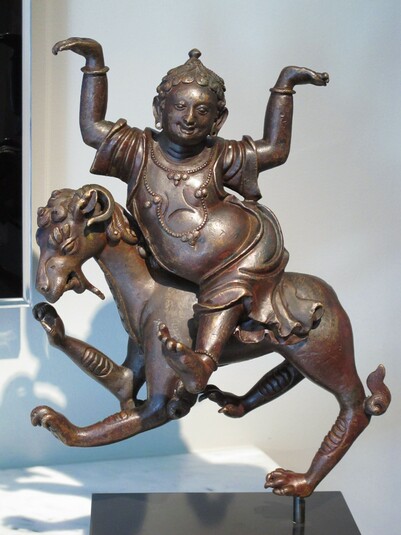
Item: Miscellaneous - Torana
| Origin Location | Tibet |
|---|---|
| Date Range | 1600 - 1699 |
| Lineages | Buddhist |
| Material | Metal |
| Collection | Private |
Classification: Object/Concept
Boy on a flying horse (sharabha). This cast metal sculpture is a fragment from a 'torana' the backrest of a throne supporting a Buddha or bodhisattva figure. The original work must have been an immense structure with the torana and the central image all cast in heavy metal and then assembled. The Sharabha typically stands on a lion, or in a Tibetan context a snow lion. A possible candidate for this is HAR #65152 - Snow Lion torana fragment. The physical size of the two objects is very similar as is the metal, patina (colouring and texture) and stylistic elements such as the toes and hair of the two animals.
In Tibetan and Himalayan Buddhism the ornately displayed throne-back, Torana, is known as the 'six ornament' design. The general shape is like an oval gate or frame, sometimes rectangular. On each side of the torana, at the bottom left and right are elephants. Supported above that are lions (or snow lions), a horse (often with the characteristics of other animals such as a lion, etc.). Above that is a small boy who sometimes holds a conch shell in one hand and supports a horizontal throne strut with the other. Above that is a makara (water creature). Above that is a naga - with a human upper torso and snake's tail for the bottom which extends upward. At the very top is a single garuda bird who bites down with the beak on the two extended tails of the two nagas from below, or bites down on a naga held in the outstretched arms. Sometimes there is an ornate silk canopy above the torana. It is not clear how the various elements of the torana are enumerated into the group of the 'six ornaments.' It is possible that the boy and the flying horse are grouped as one ornament.
Top Down:
Garuda
Nagas
Makaras (water monster)
Boys riding the flying horse (sharabha)
Horses (sharabha, half lion)
Lions
Elephants
Aside from the Garuda at the top of the torana with only one representation each of the other figures are paired standing at the left and right of the throne. Click on the image of the painting at the right to see an example of how the 'Six Ornaments' of a torana are stacked. Look to the Torana Page for more examples.
Symbolically the 'six ornaments' have many meanings such "as the seven things to be eliminated on the path, the six perfections, the four gathering things, the strength of the ten powers, the stainless and the clear light." (Gateway to the Temple by Thubten Legshay Gyatsho. 1971, 1979. page 46).
Jeff Watt, 9-2010
View other items in the Thematic Set: Subject: Torana Main Page (Arch, Decorative Throne Back)

